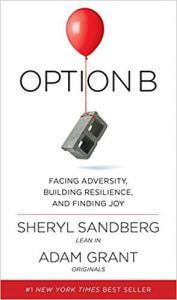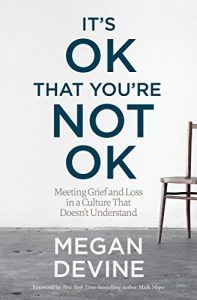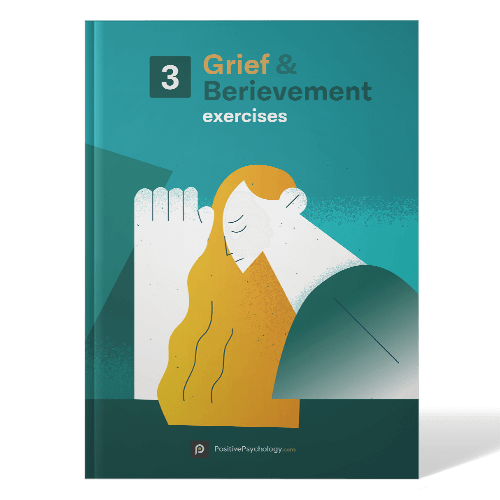9 Grief Books, Worksheets, & Journal Prompts to Help Clients
 Grief is an experience that does not discriminate.
Grief is an experience that does not discriminate.
At some point, everyone will lose a loved one.
However, no one really talks about it.
Even in therapy, talking about loss and grief can be very difficult for clients, as they often think this is something they have to keep to themselves.
This article provides clinicians with an overview of contemporary models of the grieving process, as well as worksheets and books that will help you counsel clients who have experienced a loss.
Before you continue reading, we thought you might like to download our three Grief Exercises [PDF] for free. These science-based tools will help you move yourself or others through grief in a compassionate way.
This Article Contains:
The Grief and Loss Processes Explained
Although the processes of grief and loss are largely interrelated, they may be referencing different experiences. In discussion with clients who have experienced a death, grief and loss might be used interchangeably to describe your client’s reaction to the death of a loved one.
Despite their similarities, it is important to understand the appropriate terminology and references for both grief and loss. When we say someone has experienced a loss, we are talking about the loss of a loved person or thing.
Concurrently, grief consists of the emotional and physical reactions that occur when one experiences a loss. It is characterized by deep feelings of sadness and, often, a powerful longing to see or talk to a loved one again (Whalley & Kaur, 2020).
To better understand the emotions that people go through during the grieving process, mental health professionals and researchers have come up with models to characterize the emotions people experience when they lose a loved one. Here are two of the most common.
The five stages of grief model
The five stages of grief model by Kübler-Ross (1969) is one of the most well-known models of the grieving process and lays out an individual’s response to grief and loss.
The model breaks down specific stages that grieving individuals experience and is based on Kübler-Ross’s work with terminally ill patients. Each stage is described below (Gregory, 2021).
- Denial
Feelings of avoidance. Individuals in this stage often deny the loss and are effectively numb to it. - Anger
Individuals who are experiencing anger upon losing someone might ask ‘why me?’ and think ‘life is not fair.’ - Bargaining
Also known as false hope, this stage is characterized by negotiation. Individuals might make promises to themselves (e.g., “If I change this, things might get better.”). - Depression
Individuals in this stage often withdraw from life, avoid other people, and may not want to get out of bed. This emotion can prevail throughout the grieving process. - Acceptance
When individuals enter the acceptance stage, they start to rebuild their life and realize that the person who has been lost is not coming back. They accept their new reality, and even though their life is no longer the same, they can still enjoy it.
The five-stage model of grief has received a great deal of criticism. The most prominent criticism is that grieving individuals do not go through these stages linearly, as the grieving process is considered to be unique for every person.
However, Kübler-Ross and Kessler (2004) clarified the use of the model in their book On Grief and Grieving. They explained that individuals might experience none of the stages outlined in the model. However, even though not every person may go through these stages, they note that most individuals who grieve go through one or more of these emotions.
TEAR Model
In contrast to the five-stage model, Worden’s (2018) model emphasizes that individuals who have experienced a loss are not passive agents who move through stages of grief.
Instead, Worden states that individuals going through the grieving process should become empowered and engage in rebuilding their life after loss (Bates-Maves, 2020).
The primary goal of Worden’s work is to give individuals the opportunity to adapt to their life after loss and revisit each stage as needed.
Each stage of Worden’s (2018) model is outlined below.
- To accept the reality of the loss
This stage involves your client’s ability to fully take in the death of the lost individual. An example of this would be acknowledging that the individual has passed at the funeral or memorial. Revisiting this stage could potentially happen a few years later, during an event that the deceased person would have attended. - Experience the pain of the loss
This stage encourages clients to engage in the grieving process emotionally, cognitively, and physically. Instead of bottling up their grief, they are encouraged to express their feelings in any way that resonates with them. - Adjust to the new environment without the lost person
When an individual experiences loss, they often have to restructure certain aspects of their life. Adjustments can be spiritual, internal, or external, depending on which aspects of their life have been most affected by the loss. - Reinvest in the new reality
This stage involves finding a balance between keeping the memory of the deceased alive and recreating the individual’s new reality.
3 Worksheets to Support Your Clients

However, the grieving process is considered to be highly unique for each person. For example, clients may describe multiple losses as having different effects and may compare the grieving process that they have experienced for every loss.
To help, we have created several worksheets that you can provide for your clients, no matter what stage of the grieving process they are in.
Emotions in Grieving
Your clients may experience a wide range of emotions, including guilt, shame, and depression, while grieving. Often, they might interpret the difference in the grieving process to be a direct reflection on how they felt about the person they have lost.
This Emotions in Grieving worksheet can help your clients understand the emotions they are feeling while grieving and gives them an opportunity to rate the emotions they are experiencing daily. Tracking specific emotions can allow your clients to identify patterns and potential triggers that might make their grief more visceral.
Complete the sentence
If your clients are just starting to get in touch with their emotions surrounding grief, the Grief Sentence Completion Task can provide them with more insight surrounding specific feelings about the person who has been lost, as well as emotions that they experience when different situations arise.
Clinicians can get their clients to fill out this inventory at the beginning of their sessions to understand where they are in their grieving journey. Sentence inventories are typically used for new clients to help gain a brief history of their experiences and emotions so practitioners can better provide treatment.
Plan coping strategies
When your clients are grieving, they may feel consumed by their emotions. This makes it important for them to make a plan to engage in coping strategies when they are struggling.
This activity called My Grief Plan is a place where clients can plan out different activities that will help them cope with different situations as they come up. It also gives your clients the freedom to choose different strategies in advance depending on the situation they are in or might face in the future.
3 Journal Prompts to Help Clients Heal
When a loss is particularly traumatic or sudden, clients may not know where to start when discussing the recently deceased individual. Even if the loss was expected, such as from a terminal illness, individuals may still have trouble talking about the loss.
However, it is important for your clients to share their memories and communicate their feelings.
Carrying the psychological burden of the loss, especially if there was trauma or long-term pain associated, can be emotionally and even physically destructive to your clients over time. A key principle of grief therapy is allowing individuals to reconstruct their personal narrative (Neimeyer, 2000).
Journaling can be an excellent process for your clients, especially those who have trouble putting their emotions into words, as a means to express themselves without the fear of being judged.
A few templates to help your clients reflect on their loved ones are provided below.
- A Letter to a Loved One
This worksheet provides an opportunity to write a letter to the person who was lost and reflect on memories shared. In addition, it allows the grieving individual to communicate their feelings about the loved one. - If I Could Talk to You One Last Time…
This prompt encourages individuals to think about the best things about the person who has passed. Although this may be painful, it’s important to reflect on the things that they loved the most to keep positive memories alive. - How I Can Reshape My Future
A focus on the future is essential for individuals to move forward and reshape their life. This journal entry prompt gives them the opportunity to plan for the future, while considering the perspective of the person who has recently passed. This allows the individual they are missing to remain present in their future plans, while equipping the person who’s grieving with the tools to move forward.
Top 3 Books About Grief and Loss
One of the most important things that clients tend to forget when experiencing grief and loss is that they are not alone in this experience. Even though every person’s grief takes a different path, knowing that other people have gone through a similar process can be very reassuring for your clients.
This section provides a few books that detail other people’s experiences with grief in a variety of contexts. Many of these books were inspired by the loss of a loved one and detail the pathway the author chose to help cope with their new reality.
1. It’s OK That You’re Not OK: Meeting Grief and Loss in a Culture That Doesn’t Understand – Megan Devine
This book details the experience of a woman who lost her husband in an accidental drowning.
Devine is also a therapist who can provide personal and clinical insights about the grieving process.
Devine aims to debunk the concept of resuming a happy, normal life after grief, instead encouraging readers to build a new life alongside their grief. She acknowledges the all-encompassing nature of grief and provides practical guidance for managing the stress that comes with the grieving process.
The book addresses specific strategies for managing sleep and stress for those who have recently lost someone.
Find the book on Amazon.
2. Option B: Facing Adversity, Building Resilience, and Finding Joy – Sheryl Sandberg and Adam Grant

A few weeks after his death, Sandberg was preparing for a father–child activity and cried out that she wanted her husband.
Her friend told her that Option A was no longer available and that she needed to make the most of Option B, the one in which her husband was no longer there.
Sandberg and Grant focus on the power of resilience, explaining that resilience comes from deep within us and can be activated from support we receive from others. Sandberg not only documents her own struggle with losing her husband, but highlights resilience in others through telling stories of their individual struggles not limited to the loss of a loved one (e.g., war, illness, assault).
By telling these stories, Sandberg and Grant provide real-life examples of resilience, which can provide your clients with inspiration as they go through the grieving process.
Find the book on Amazon.
3. The Year of Magical Thinking – Joan Didion
In this book, Didion describes one of the hardest years of her life, when she lost her husband and helped her daughter recover from a serious illness that almost killed her.
She describes how she got through that difficult year, highlighting a form of ‘magical thinking’ that constantly crossed her mind.
Didion details an example of this thinking as wondering if her husband is going to come back and get his shoes one day. This is the kind of thought that several of your clients might have, especially when they experience events for the first time without their loved one or see something that is reminiscent of them.
The description of this thinking process and other emotions that Didion experienced makes this an excellent book to help illustrate a few of the thoughts and feelings that a client might experience during that difficult first year after a loved one has passed.
Find the book on Amazon.
Resources From PositivePsychology.com
Our website provides several resources that your clients can use if they have recently experienced a loss or need help to deal with grief. The Positive Psychology Toolkit© has several activities that are aimed at helping your clients cope with grief.
One of the most impactful activities is entitled Journaling Through Grief in 40 Days. The activity provides your clients with structured prompts to help make journaling more consistent. By the end of this exercise, clients will have an extensive collection of journal entries that they can further reflect on in therapy or to help facilitate personal growth in the grieving process.
If your clients are still struggling with writing down or describing their emotions, the Metaphors of Grief worksheet can help personify their grief using relatable descriptive statements.
The Life Certificate exercise gives individuals the opportunity to reflect on the positive qualities of the person who died. It also gives them the opportunity to immortalize their accomplishments, as they can write down the things that were most important to them about the deceased.
These resources and more can be accessed with a subscription to the Positive Psychology Toolkit©. With over 400 tools, exercises and worksheets, the toolkit is a must-have resource for therapists assisting clients with grief.
In addition, we have compiled an article specifically to help kids cope with grief that contains a selection of six books and a number of helpful tips.
A Take-Home Message
Although everyone experiences loss, the impact and experience of each loss are vastly different. Whether you have lost a pet, relative, friend, parent, spouse, or child, no two losses are uniform.
Understanding that the grieving process is not the same for every individual and can differ depending on the magnitude and nature of the loss is essential in helping your clients cope with grief.
Having knowledge about the unique nature of the grieving process can also de-stigmatize responses that your clients might have toward death and dying, making it easier for them to express their emotions in whatever way is most helpful for them.
We hope this article provides you with helpful resources to help your clients when they are experiencing grief. It is also important to remember that these resources are a supplement to open conversation.
Often when an individual has lost someone they love, being an active listener is the best form of therapy. Give them an open door to cry, share their memories, or simply be silent and reflect if that is what brings them comfort.
Be patient, open minded, and accepting of the various forms grief might take, and know that support is always available.
We hope you enjoyed reading this article. Don’t forget to download our three Grief Exercises [PDF] for free.
- Bates-Maves, J. (2020). Grief and addiction: Considering loss in the recovery process. Routledge.
- Gregory, C. (2021, May 4). The five stages of grief: An examination of the Kübler-Ross Model. Psycom. Retrieved July 9, 2021 from https://www.psycom.net/depression.central.grief.html
- Devine, M. (2017). It’s OK that you’re not OK: Meeting grief and loss in a culture that doesn’t understand. Sounds True.
- Didion, J. (2007). The year of magical thinking. Knopf Doubleday.
- Kübler-Ross, E. (1969). On death and dying. MacMillan.
- Kübler-Ross, E., & Kessler, D. (2004). On grief and grieving: Finding the meaning of grief through the five stages of loss. Scribner.
- Neimeyer, R. A. (2000). Lessons of loss: A guide to coping. PsychoEducational Resources.
- Sandberg, S., & Grant, A. (2017). Option B: Facing adversity, building resilience, and finding joy. Knopf.
- Whalley, M., & Kaur, H. (2020, August 4). Grief, loss and bereavement. Psychology Tools. Retrieved July 9, 2021 from https://www.psychologytools.com/self-help/grief-loss-and-bereavement/
- Worden, J. W. (2018). Grief counseling and grief therapy: A handbook for the mental health practitioner. Springer.
Let us know your thoughts
Read other articles by their category
- Body & Brain (41)
- Coaching & Application (49)
- Compassion (27)
- Counseling (46)
- Emotional Intelligence (23)
- Gratitude (16)
- Grief & Bereavement (19)
- Happiness & SWB (35)
- Meaning & Values (26)
- Meditation (21)
- Mindfulness (42)
- Motivation & Goals (42)
- Optimism & Mindset (33)
- Positive CBT (24)
- Positive Communication (21)
- Positive Education (41)
- Positive Emotions (28)
- Positive Psychology (33)
- Positive Workplace (38)
- Relationships (31)
- Resilience & Coping (33)
- Self Awareness (21)
- Self Esteem (38)
- Software & Apps (23)
- Strengths & Virtues (28)
- Stress & Burnout Prevention (27)
- Theory & Books (42)
- Therapy Exercises (30)
- Types of Therapy (53)






What our readers think
I happened across the article doing research for a workshop on resilience. We lost our son 6/23/2013 in a DWI crush he was 21 turning 22 December 5 he was my first born, I miss him so. I recently read that the pain doesn’t decrease we just grow around it, well said. He was a joy to everyone that know him. I can imagine that most mothers say this but I have testimonies of the fact. I wish that I had this years ago but everything in its time. I’m at work with tears in my eyes, thank you I will share this with my family and friends. God Bless you.